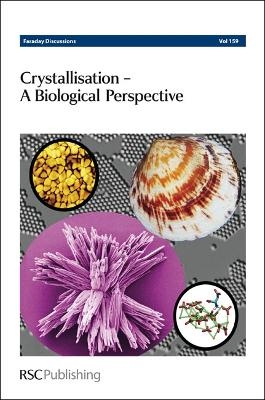
Crystallisation - A Biological Perspective
Royal Society of Chemistry (Verlag)
978-1-84973-450-9 (ISBN)
Faraday Discussions documents a long-established series of Faraday Discussion meetings which provide a unique international forum for the exchange of views and newly acquired results in developing areas of physical chemistry, biophysical chemistry and chemical physics. The papers presented are published in the Faraday Discussion volume together with a record of the discussion contributions made at the meeting. Faraday Discussions therefore provide an important record of current international knowledge and views in the field concerned. The latest (2012) impact factor of Faraday Discussions is 3.82.
Introductory Lecture: Spiers Memorial Lecture: Effect of interaction specificity on the phase behaviour of patchy particles;
Amino acids form prenucleation clusters: ESI-MS as a fast detection method in comparison to analytical ultracentrifugation;
Probing the structure and stability of calcium carbonate pre-nucleation clusters;
Exploring the influence of organic species on pre- and post-nucleation calcium carbonate;
Control of the nucleation of sickle cell hemoglobin polymers by free hematin;
Structural evolution, formation pathways and energetic controls during template-directed nucleation of CaCO3;
A two-step mechanism for crystal nucleation without supersaturation;
General discussion;
Phase behavior of colloidal silica rods;
Inorganic salts direct the assembly of charged nanoparticles into composite nanoscopic spheres, plates, or needles;
Real-space studies of the structure and dynamics of self-assembled colloidal clusters;
Aggregation of ferrihydrite nanoparticles in aqueous systems;
Biomimetic type morphologies of calcium carbonate grown in absence of additives;
Computer simulation of soft matter at the growth front of a hard-matter phase: incorporation of polymers, formation of transient pits and growth arrest;
General discussion;
A metastable liquid precursor phase of calcium carbonate and its interactions with polyaspartate;
The role of cluster formation and metastable liquid—liquid phase separation in protein crystallization;
Polymer-induced liquid precursor (PILP) phases of calcium carbonate formed in the presence of synthetic acidic polypeptides—relevance to biomineralization;
Precipitation of ACC in liposomes—a model for biomineralization in confined volumes;
The role of the amorphous phase on the biomimetic mineralization of collagen;
Revisiting geochemical controls on patterns of carbonate deposition through the lens of multiple pathways to mineralization;
General discussion;
Aragonite crystal orientation in mollusk shell nacre may depend on temperature. The angle
spread of crystalline aragonite tablets records the water temperature at which nacre was deposited by Pinctada margaritifera;
Merging models of biomineralisation with concepts of nonclassical crystallisation: is a liquid amorphous precursor involved in the formation of the prismatic layer of the Mediterranean Fan Mussel Pinna nobilis?;
Oligomer formation, metalation, and the existence of aggregation-prone and mobile sequences within the intracrystalline protein family, Asprich;
GSP-37, a novel goldfish scale matrix protein: identification, localization and functional analysis;
CaCO3/Chitin hybrids: recombinant acidic peptides based on a peptide extracted from the exoskeleton of a crayfish controls the structures of the hybrids;
General discussion;
Concluding remarks;
The thermodynamics of calcite nucleation at organic interfaces: Classical vs. non-classical pathways;
Poster titles;
list of participants;
index of contributors
| Erscheint lt. Verlag | 30.11.2012 |
|---|---|
| Reihe/Serie | Faraday Discussions ; Volume 159 |
| Mitarbeit |
Sonstige Mitarbeit: Royal Society of Chemistry |
| Verlagsort | Cambridge |
| Sprache | englisch |
| Maße | 156 x 234 mm |
| Gewicht | 980 g |
| Themenwelt | Naturwissenschaften ► Biologie |
| Naturwissenschaften ► Chemie | |
| Naturwissenschaften ► Geowissenschaften ► Mineralogie / Paläontologie | |
| ISBN-10 | 1-84973-450-X / 184973450X |
| ISBN-13 | 978-1-84973-450-9 / 9781849734509 |
| Zustand | Neuware |
| Haben Sie eine Frage zum Produkt? |
aus dem Bereich


